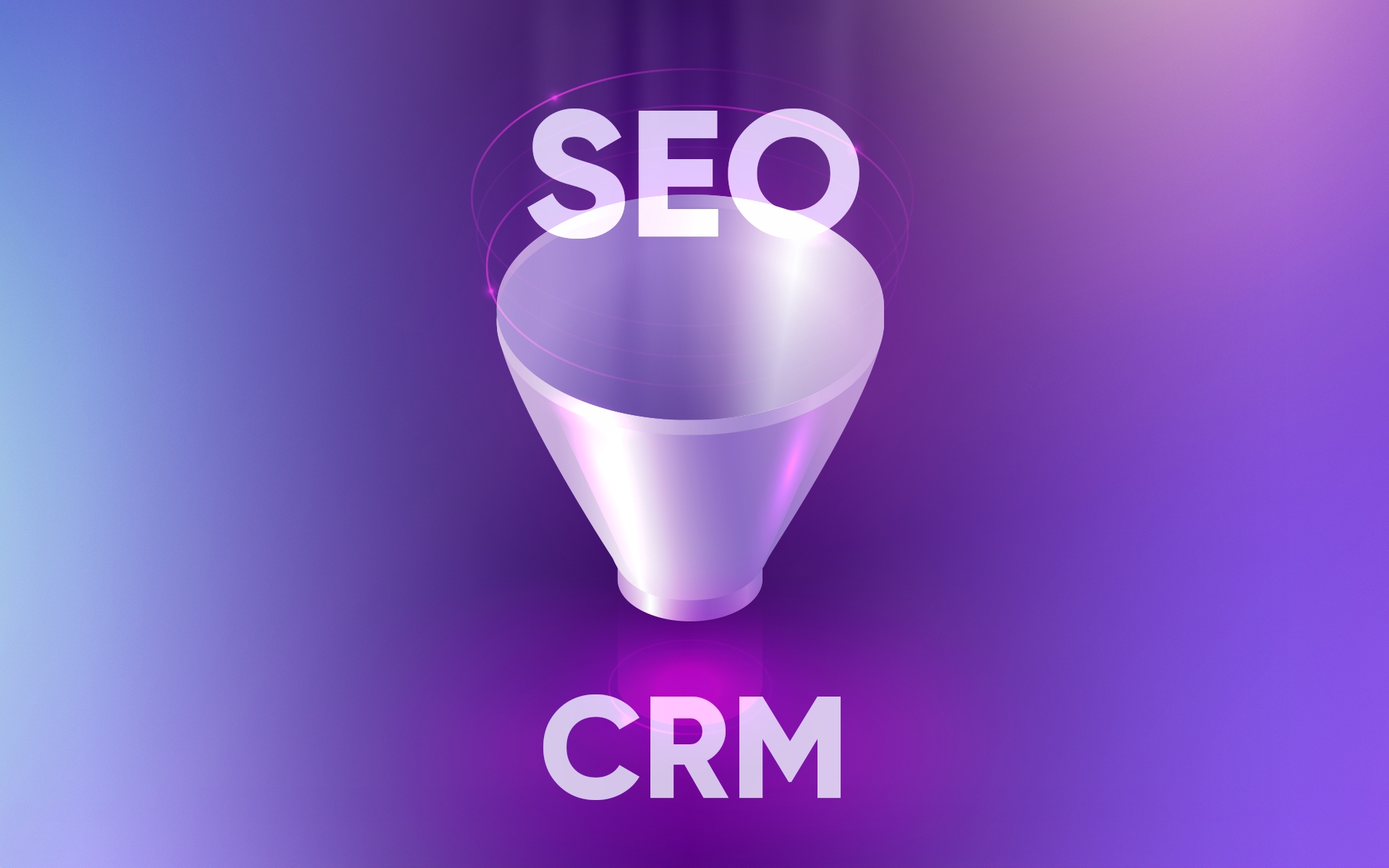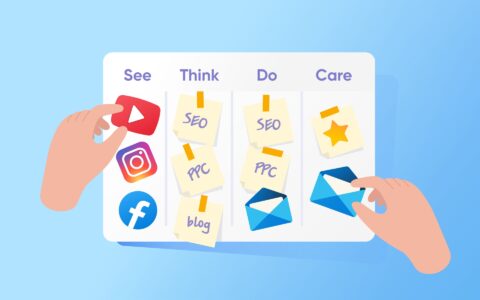Search engine optimization strategy and customer relationships management software are on the opposite sides of a sales funnel. This doesn’t mean they should be kept completely separate. If your organization wants to adopt a data-driven mindset, combine data from your CRM and SEO analytics to improve your whole lead pipeline.

In this article, we’ll look at the relationship between CRM and SEO, how CRM data can improve SEO and vice versa, as well as how both can improve the overall lead generation strategy.
What Is the Connection Between CRM and SEO
Both search engine optimization and customer relationship management are an important part of the sales funnel. SEO deals with top-of-the-funnel engagement by ensuring new people enter your site and leave their contact information or convert in another way. CRM deals with mid and bottom-of-the-funnel operations.
Despite being on the opposite ends of the lead pipeline, using insights from the data collected on both can help you improve the pipeline as a whole.
The main goal of SEO is to get people from Google search to your website and make a converting action of some kind. It may be something small, like subscribing to the newsletter and leaving information about their company, or something big, like setting up a trial account.
Apart from providing the initial bits of information about the lead to a CRM, data on lead behavior on the top of the funnel can be used to improve your understanding of what can make them convert.
The data you gather in the CRM during lead interactions can help you understand the types of your leads and their preferences. This is important for SEO as it can help you inform your content strategy.
Let’s dive deeper into each strategy that you can use to enhance your pipeline.
How to Use SEO to Improve CRM
The data you gather from your SEO efforts can improve your lead generation strategy. Here are three ways you can do this.
Identify Lead Interests Through Content Engagement
A major part of SEO is content marketing. This strategy includes creating different types of content for your corporate blog to educate users on topics related to your products and services. It’s often the first touchpoint with your brand and a source of new leads.
How exactly visitors interact with the content can tell you a lot about their interests. Website engagement metrics like time on site, scroll depth, and the number of pages per visit can let you understand what types of content and topics your leads prefer.
This can highlight a common prevalent interest, whether in educating themselves or in solving a pain point.
You can use these findings to figure out which pain points are most relevant to your leads to improve conversions. If a particular piece of content generates a lot of engagement, consider expanding on it in eBooks and webinars, as it might be relevant to your user base.
Track User Behavior Across the Funnel
In SEO, you’ll likely track user behavior on the website to learn more about the user paths to conversion. While you’re going to use that information to optimize top-of-the-funnel conversion, it’s also useful for improving your CRM.
The conversion patterns of users browsing the website organically can inform your email marketing efforts. If you notice that users who are interested in particular topics often sign up for a webinar, you can suggest this webinar to all users who view those topics.

Improve Lead Profiles with SEO Insights
Apart from optimization of the lead pipeline, you can use data from your SEO offers to add more information to the lead profiles.
Analyzing the performance of the landing pages, both the keywords that people use to find them and the conversion rates with different page copies can show important pain points for different segments of the user base.
Monitoring traffic sources can help with both lead attribution and understanding the content preferences of your leads.
SEO typically has many sources you have to analyze. A tool like a website SEO checker by SE Ranking can help you get all necessary SEO data in a single interface that’s easy to explore. It also makes generating reports easy, which is handy since you have to share the data with the sales team.
How to Use CRM Insights to Optimize SEO Strategy
The data you receive on your CRM can improve your SEO strategy. Here are four strategies to do this.
Understand Who Your Customers Are
The biggest benefit of using CRM data to inform your SEO strategy is that your marketing team can understand who your customers are even better. Use data from your CRM to form a more complete ideal customer profile.
Use this information to create a better SEO strategy. In particular, you’ll want to take a closer look at customer pain points and common objections highlighted by CRM insights. Use these to target new keywords and create new content.
You can use this understanding to inform the style and tone of your content as well.
Improve User Experience (UX)
A website designed with user experience in mind helps with improving the customer experience of browsing it and the conversion rate as a result. It can also help improve SEO. With a good UX, especially on the blog pages, users are likely to stay on the page for longer, browse more pages, and improve user engagement metrics. This can influence your ranking on Google slightly.
Data from your customer relationship management software can point to places where you can optimize UX. For instance, how you can improve website navigation, or simplify lead capture forms.
Another important aspect of the site that you can improve with the CRM data is personalized content suggestions. Data on what type of topics your leads are interested in can guide your suggestions, especially if it’s properly segmented.
Generate Content Ideas from CRM Data
CRM data shows you how your users engage with different topics and the questions they frequently ask, you can use it to come up with new content ideas that would help your SEO efforts.
The email marketing engagement metrics, like opens and clicks, can suggest what type of content your newsletter subscribers and current users are more interested in. This may signal to produce more content on the topics your subscribers love.
The questions that active users and leads frequently ask your salespeople and customer support staff can be turned into content ideas. Popular misinterpretations of your offerings or problems people encounter with the products show a gap in knowledge. You can fill that gap with appropriate content.
Develop Segment-Specific Content
Since your CRM can segment leads both by their type and by the stage of the sales funnel, you can narrow down the content you create for each specific segment.
For instance, email marketing engagement data that shows which content people interact with the most can be segmented. This can show you which content to serve to each segment, especially at the top of the funnel.
Since the questions your sales and CS team receive will typically be practical, you can create content for the middle and bottom of the funnel based on them.
How to Improve Conversion Rate Optimization (CRO) with SEO and CRM Data
CRM in connection with web design and SEO, can be used to improve other aspects of your digital marketing strategy. For instance, conversion rate optimization. Here are two ways you can do that.
Optimize Landing Pages Using Combined Data
Both SEO and CRM data can inform you on how to improve your landing pages.
Search engine optimization itself is connected to the landing pages because you have to draw organic search traffic to them. Doing deep research on the keywords your leads might be using to find your products or services helps with attracting the right kind of people to your site.
Using the right keywords and analyzing them to figure out the exact search intent will help you attract traffic that might convert better because their interests and your messaging are aligned.
You can use behavioral data like the bounce rate and scroll depth to understand which pages drive visitors away and form an understanding of what exactly they don’t like.
CRM data can highlight client pain points, objections, and misunderstandings of your product. Use these findings to improve the copy on your landing pages.
Personalize Content Recommendations
Using data from SEO and CRM systems can help you create a content funnel that effectively propels leads to the next stage. This mostly relies on understanding the buyer’s journey on the website — how they browse content and how they typically convert.
For instance, if you know that most users will sign up for a webinar after viewing ten posts, you can start recommending webinars more for sessions with ten-page views. Or, if there’s a specific webinar topic connected to the types of blog posts users engage with, you can personalize the recommendation based on the pages the user views.

How to Implement a Cohesive SEO-CRM Strategy
If you want to use data from SEO and CRM effectively, you’ll need to do two major things first: integrate the data and align the teams in a single vision. Let’s explore each in a bit more detail.
Integrate CRM and SEO Platforms
Data-driven companies make more money, and the first step to using data effectively is to store it in one place. Most CRMs don’t have SEO tools included, nor do SEO tools offer CRM capabilities. You can integrate tools that monitor organic traffic, like Google Analytics or Google Search Console, with your CRM or ask your CRM support team for custom integration with other SEO tools.
If neither option works for you, it’s best to pool data in a third place. You can use a data management service to extract data from the CRM and SEO tools into a single database. This will give you an opportunity to run advanced analytics on the combined data, explore it, and find insights into it.
Align Sales and Marketing Teams
The next step is making sure your sales and marketing teams are on the same page. They have to have a set of shared company-wide goals and understand how their work affects that goal. This will help both make decisions based on the data they have and have the curiosity to explore new solutions.
Once they have that, it’s crucial that both teams have access to quality data. One solution is to train everyone on data exploration and provide access to an unified database. This way, the teams won’t only have the data from their tools that might show a slightly distorted view. They’ll access the whole picture.
It helps if the data solution you invest in has great data exploration and visualization capabilities because browsing raw data might be confusing.
Another option is to make a monthly report or a dashboard that highlights the data that might be relevant for the other team. This task can be automated to save time, or the teams can only share the most interesting findings.
Summary
Every business can benefit from evolving a view of it as one united mechanism, not just multiple components doing separate tasks. This approach lets everybody involved understand how the whole business works and create better ideas to move it further toward shared goals.
Following SEO and CRM best practices definitely improves your business. Uniting the data gathered by these can show you the bigger picture and give you the ability to find better insights. With SEO and CRM data in particular, you can improve both marketing and sales, as well as work on conversion rate optimization.
Take this idea further and explore the option of creating a unified database for all parts of your business.











